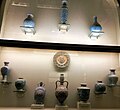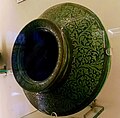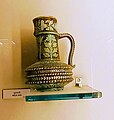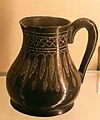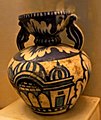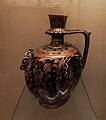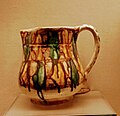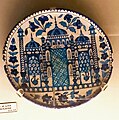
Delftware or Delft pottery, also known as Delft Blue or as delf, is a general term now used for Dutch tin-glazed earthenware, a form of faience. Most of it is blue and white pottery, and the city of Delft in the Netherlands was the major centre of production, but the term covers wares with other colours, and made elsewhere. It is also used for similar pottery, English delftware.

The Percival David Foundation of Chinese Art holds a collection of Chinese ceramics and related items assembled by Percival David that are on permanent display in a dedicated gallery in Room 95 at the British Museum. The foundation's main purpose is to promote the study and teaching of Chinese art and culture. The collection has some 1,700 pieces, mostly of Song, Yuan, Ming and Qing dynasty porcelain from the 10th century to the 18th. It includes a painting, Scroll of Antiquities.

Mintons was a major company in Staffordshire pottery, "Europe's leading ceramic factory during the Victorian era", an independent business from 1793 to 1968. It was a leader in ceramic design, working in a number of different ceramic bodies, decorative techniques, and "a glorious pot-pourri of styles - Rococo shapes with Oriental motifs, Classical shapes with Medieval designs and Art Nouveau borders were among the many wonderful concoctions". As well as pottery vessels and sculptures, the firm was a leading manufacturer of tiles and other architectural ceramics, producing work for both the Houses of Parliament and United States Capitol.
Kripal Singh Shekhawat (1922-2008) was a renowned craftsman and ceramist of India. He was famous for his skills in Blue Pottery of Jaipur and is credited for the revival of that art in India.

Blue pottery is widely recognized as a traditional craft of Jaipur of Central Asian origin. The name 'blue pottery' comes from the eye-catching cobalt blue dye used to colour the pottery. It is one of many Eurasian types of blue and white pottery, and related in the shapes and decoration to Islamic pottery and, more distantly, Chinese pottery.

Pottery in the Indian subcontinent has an ancient history and is one of the most tangible and iconic elements of Indian art. Evidence of pottery has been found in the early settlements of Lahuradewa and later the Indus Valley Civilisation. Today, it is a cultural art that is still practiced extensively in the subcontinent. Until recent times all Indian pottery has been earthenware, including terracotta.

The Kingdom of Amber, later known as the Jaipur State and also the Kingdom of Jaipur, was located in the north-eastern historic Dhundhar region of Rajputana and was ruled by the Kachwaha Rajput clan. It was established by Dulha Rai, possibly the last ruler of the Kachchhapaghata dynasty of Gwalior who migrated to Dausa and started his kingdom there with the support of Chahamanas of Shakambhari in the 12th century. Mostly through 12th to 15th century, the kingdom faced stagnation, sources were scarce. Under its ruler, Raja Chandrasen of Amber became a Sisodia vassal and fought in the Battle of Khanwa under Raja Prithviraj Kachhwaha.

Medici porcelain was the first successful attempt in Europe to make imitations of Chinese porcelain, though it was soft-paste porcelain rather than the hard-paste made in Asia. The experimental manufactory housed in the Casino of San Marco in Florence existed between 1575 and 1587 under the patronage of Francesco I de' Medici, Grand Duke of Tuscany. Surviving examples are extremely rare, numbering 59 according to the Metropolitan Museum of Art.

Sir Samuel Swinton Jacob,, known as Sir Swinton Jacob, was a British Army officer and colonial engineer, architect and writer, best known for the numerous Indian public buildings he designed in the Indo-Saracenic style.

Art pottery is a term for pottery with artistic aspirations, made in relatively small quantities, mostly between about 1870 and 1930. Typically, sets of the usual tableware items are excluded from the term; instead the objects produced are mostly decorative vessels such as vases, jugs, bowls and the like which are sold singly. The term originated in the later 19th century, and is usually used only for pottery produced from that period onwards. It tends to be used for ceramics produced in factory conditions, but in relatively small quantities, using skilled workers, with at the least close supervision by a designer or some sort of artistic director. Studio pottery is a step up, supposed to be produced in even smaller quantities, with the hands-on participation of an artist-potter, who often performs all or most of the production stages. But the use of both terms can be elastic. Ceramic art is often a much wider term, covering all pottery that comes within the scope of art history, but "ceramic artist" is often used for hands-on artist potters in studio pottery.
Ram Niwas Garden is a garden situated in Jaipur city in Indian state of Rajasthan, built by Maharaja Sawai Ram Singh of Jaipur in 1868.

The City Palace, Jaipur is a royal residence and former administrative headquarters of the rulers of the Jaipur State in Jaipur, Rajasthan. Construction started soon after the establishment of the city of Jaipur under the reign of Maharaja Sawai Jai Singh II, who moved his court to Jaipur from Amber, in 1727. Jaipur remained the capital of the kingdom until 1949—when it became the capital of the present-day Indian state of Rajasthan—with the City Palace functioning as the ceremonial and administrative seat of the Maharaja of Jaipur. The construction of the Palace was completed in 1732 and it was also the location of religious and cultural events, as well as a patron of arts, commerce, and industry. It was constructed according to the rules of vastushastra, combining elements of Mughal and Rajput architectural styles. It now houses the Maharaja Sawai Man Singh II Museum, and continues to be the home of the Jaipur royal family. The royal family has around 500 personal servants. The palace complex has several buildings, various courtyards, galleries, restaurants, and offices of the Museum Trust.The MSMS II Museum Trust is headed by chairperson Rajamata Padmini Devi of Jaipur. Princess Diya Kumari runs the Museum Trust, as its secretary and trustee. She also manages The Palace School and Maharaja Sawai Bhawani Singh School in Jaipur. She founded and runs the Princess Diya Kumari Foundation to empower underprivileged and underemployed women of Rajasthan. She is also an entrepreneur. In 2013, she was elected as Member of the Legislative Assembly of Rajasthan from the constituency of Sawai Madhopur.

The Albert Hall Museum in Jaipur is the oldest museum of the state and functions as the state museum of Rajasthan, India. The building is situated in Ram Niwas garden outside the city wall opposite New gate and is a fine example of Indo-Saracenic architecture. It is also called the Government Central Museum. It was considered one of the best 19th century museums for the variety of its collections. It was renovated in 2008 and reopened as one of the most advanced museums in India.

Newcomb Pottery, also called Newcomb College Pottery, was a brand of American Arts & Crafts pottery produced from 1895 to 1940. The company grew out of the pottery program at H. Sophie Newcomb Memorial College, the women's college now associated with Tulane University in New Orleans, Louisiana. The Pottery was a contemporary of Rookwood Pottery, the Saturday Evening Girls, North Dakota pottery, Teco and Grueby.

Rookwood Pottery is an American ceramics company that was founded in 1880 and closed in 1967, before being revived in 2004. It was initially located in the Over-the-Rhine neighborhood in Cincinnati, Ohio, and has now returned there. In its heyday from about 1890 to the 1929 Crash, it was an important manufacturer, mostly of decorative American art pottery made in several fashionable styles and types of pieces.

The Razmnāma is a Persian translation of the Sanskrit epic Mahabharata, commissioned by the Mughal Emperor Akbar. In 1574, Akbar started a Maktab Khana or "House of Translation" in his new capital at Fatehpur Sikri. He assigned a group to translate the Sanskrit books Rajatarangini, Ramayana and Mahabharata into the Persian language, the literary language of the Mughal court.

Ru ware, Ju ware, or "Ru official ware" is a famous and extremely rare type of Chinese pottery from the Song dynasty, produced for the imperial court for a brief period around 1100. Fewer than 100 complete pieces survive, though there are later imitations which do not entirely match the originals. Most have a distinctive pale "duck-egg" blue glaze, "like the blue of the sky in a clearing amongst the clouds after rain" according to a medieval connoisseur, and are otherwise undecorated, though their colours vary and reach into a celadon green. The shapes include dishes, probably used as brush-washers, cups, wine bottles, small vases, and censers and incense-burners. They can be considered as a particular form of celadon wares.
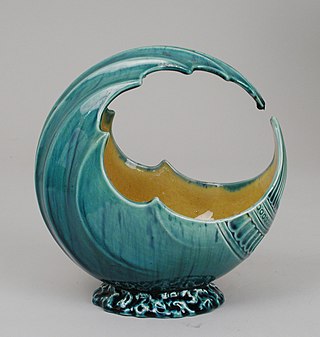
Linthorpe Art Pottery was a British pottery that operated between 1878 and 1890 in Linthorpe, Middlesbrough. It produced art pottery, and is especially known for the early collaboration of the designer Christopher Dresser; many of the early wares have his impressed signature.

Auguste Delaherche was a French ceramicist, who was a leading figure in French art pottery through the Art Nouveau period. Like other leading French potters of the period, he was intensely interested in ceramic glaze effects of colour and surface texture. He began his career making stoneware, but later also made porcelain in his studio.

Chandramani Singh was an Indian art historian, textile expert, writer and a museum archivist based in Jaipur, Rajasthan. As a writer, Singh had edited and authored numerous works on museums, culture, and heritage. Her notable works include Jaipur Rajya ka Itihas, Art Treasures of Rajasthan, Performing Arts of Rajasthan: Lok-Rang, and Protected Monuments of Rajasthan among others. She was associated with Banaras Hindu University, the Sawai Mansingh II City Palace Museum and Jawahar Kala Kendra. She had also worked for the restoration of the Jaigarh Fort, Jaipur. She died in 2022 after a prolonged illness.





